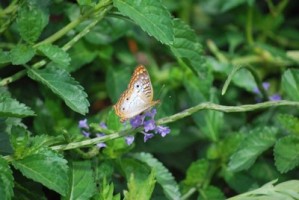What’s more lovely than a garden whose flowers attract butterflies? And what’s a better way to teach school children about nature than showing them how to garden? To celebrate Broward County’s hundred birthday, the Broward Centennial Habitat Gardens Project has put those two ideas together, and Broward County is all the luckier for it.
Funded by the Community Foundation of Broward and organized by the National Wildlife Foundation in partnership with Youth Environmental Alliance (YEA) and NatureScape Broward, the Broward Centennial Habitat Gardens Project is expanding existing gardens in public places and adding new ones, for a total of 100 in all. The project, which aims to stem the loss of habitat for monarch butterflies and other pollinators, began earlier this year and should be completed by late October or early November, weather permitting, says Kimberly Mayo, program assistant at NatureScape. The loss of habitat throughout the United States is due to development and the spraying of agricultural pesticides, Kim said.
One recent afternoon, Kim had just gotten back from a garden project at Parkside Elementary School in Coral Springs, where about 40 second- and third-graders learned to dig holes, remove plants from their pots without hurting them, place the plants into the holes, add backfill and water, and perhaps place mulch around them, if they required mulch, Kim said. The children watered the plants from buckets, not directly from a hose, she pointed out.
“It’s not a good idea to give seven-year-olds the hose. We know what’s going to happen — I can guarantee you that everybody will get a shower,” Kim said. And thanks to Mother Nature’s good timing, as soon as the young gardeners had finished their planting, it began to rain!

Before the program ends, it looks to have worked with 10,000 students, from elementary through high school. Each time there is a garden project at a school, Kristen Hoss, from the Dania-based Youth Environmental Alliance, first explains the basics in an indoor class, covering such things as the importance of pollinators, which range from butterflies to honeybees to other insects and hummingbirds. The students learn how to identify different types of butterflies, and which host plant each type needs to lay its eggs on. Adult monarch butterflies can’t reproduce if they can’t find milkweed plants to lay their eggs on, for example, and upon hatching from those eggs, the caterpillars will only eat milkweed. Once a caterpillar has eaten as much as it can, it goes into a chrysalis for a few days, or a week or longer, before emerging as a butterfly, Kim said. Unlike their younger selves, butterflies get their nutrients from the nectar of flowers.
Each school, library, or park wishing to get a new garden, or to expand an existing one, can apply for a grouping of plants to suit their site, from among four types of gardens: Monarch Mania, Basic Butterfly, Wetland Garden, and Shade Garden. Each garden kit contains 15 native butterfly plants, including milkweed for monarch butterflies. And the other plants in the kits provide food for other pollinators. The program helps applicants choose the type of garden best suited for their sites, along with the placement and arrangement of the plants, Kim said. Applicants can also request native tree seedlings from the National Wildlife Federation, which students can take home and plant.
Asked how long it takes a new garden to attract butterflies, Kim said she’s been to events at schools where as soon as the plant pots were put out onto the parking lot, butterflies showed up. Although 60 of the 100 gardens are, or will be, on school grounds, and thus off-limits to the public, anyone can visit the ones at parks and libraries.